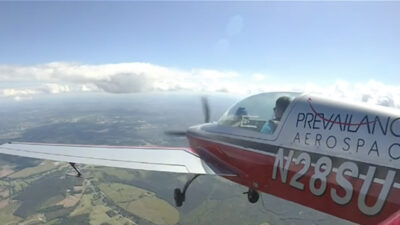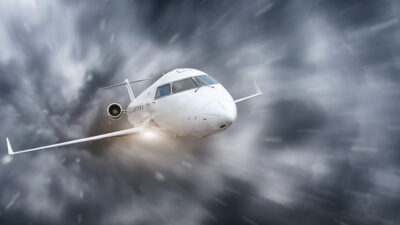Got eVTOL?

Electric vertical take-off and landing (eVTOL) vehicles bring out the very best futuristic, gravity-defying and green versions of us all. The idea is not entirely new, offering vertical movement with lateral mobility and making the concept of a runway almost trivial.
It offers blades and batteries and a quiet that few know in our existing aviation world. It dares us to conceive of having an eVTOL in the backyard where maybe the neighbors won’t notice as we skip traffic and fly into work with efficiency. The days of loud and objectionable aircraft are soon to be behind us, and it feels like we can literally have it all.
eVTOL: Exciting Technology, But Who’s Flying the Plane?
The eVTOL concept has taken years to bring to fruition, and I have done my best to stay up to date on the latest news tied to the manufacturers, mergers, acquisitions and super brands that will ultimately make life better with these vehicles. The eVTOL world is one that I want to live in, with expeditious transport in congested cities, local pickups and small vertiports that make physically connecting easier and entirely attainable.
No jet fuel or 100LL required, just a short plug into the grid, and we are collectively on our way. Everything about it just feels good.
There is one issue that concerns me—who is flying the plane? Are eVTOL pilots born out of the commercial airlines? Are they former military aviators? Can anyone with a pilot’s license take the job? Or do these pilots come to the eVTOL world fresh out of school, with thousands of hours of simulator experience as the primary bullet on their resumes?
As someone who has been in aviation and around every type of pilot for the past 20+ years, I would submit that this new breed of eVTOL pilot should be tested. I do not mean tested through intense ground school, although that is important. I mean tested in an environment that elicits the startle response. Defined as “an uncontrollable, automatic muscle reflex, raised heart rate, blood pressure, etc., elicited by exposure to a sudden, intense event that violates a pilot’s expectations,” the startle response is uniquely our own.1 Only by experiencing startle can one learn how to manage it and use that knowledge to protect their futuristic and energy-efficient aircraft and the passengers onboard.
eVTOLS and the Challenges of Urban Operations
Being familiar with startle is particularly important when operating in urban environments where there is a high population density and a very small margin for error. One eVTOL incident in an urban environment could crush the industry. Fear still exists with passengers on Part 121 commercial airline operations even though it is the safest mode of transportation. This type of passenger will want to use eVTOLs even though the fear will intensify in densely populated areas where passengers and bystanders could be impacted immediately and directly. Anything that the industry can do to minimize that fear is paramount.
There is no doubt that safety is a primary focus of manufacturers and the Federal Aviation Administration (FAA), but as mentioned previously, the eVTOL concept is entirely new. The innovators changing the game are doing so without a guidebook or manual to address every possible contingency. How could they do anything else?
They are managing inception, development, certification and growth from the perspective of prior aircraft standards and pilot certifications and, in some cases, unmanned systems integration. Industry experts have diverse perspectives, yet there is one piece of the puzzle that is often not discussed—the training of eVTOL pilots.
It is a new environment with new vehicles in a new operating area. That alone has inherent risk. In fact, just one of those three is justification for a new operational risk management (ORM) checklist. eVTOLs redefine operational limitations with zero liquid fuel requirements, fewer crew members, more automation and, sometimes, autonomous systems.
One way the industry can protect itself is by consistently keeping a human in the loop. A human who is well-trained. Not well trained in customer service, engineering, technology or manufacturing, but instead well-trained in managing startle. That includes a solid understanding of aerodynamics as initially described by the FAA back in 2015 with Advisory Circular 120-111, which addresses upset prevention and recovery training (UPRT). That human is a welcome addition to promote safety and ORM but also the peace of mind desired by the nervous passenger.
Pilots benefit from experiencing startle in a safe, stable platform to prepare for any given contingency airborne with UPRT.
A Tale of Blending Two Cultures
I have to agree with former FAA administrator Michael Huerta, who said “…the companies that will be most successful are those able to bridge the gap between two different cultures—the tech industry’s ’move fast, break things and innovate’ approach and that of aviation, a culture that is ’incredibly cautious’—and who can bring together people from those different backgrounds to help.”2
Putting extra emphasis on each eVTOL pilot’s training is paramount, and UPRT is one way to make a huge difference. It is more robust than other training methodologies available and bridges the divide in the current training paradigm and the dynamic environment that eVTOLs create.
There is no doubt that I love the eVTOL concept. My plan is to have one in my backyard as soon as possible. I think my neighbors won’t mind the peaceful transit, especially if a UPRT-experienced pilot takes them for a ride.
Resources
1 FAA Advisory Circular 120-111. https://www.faa.gov/documentLibrary/media/Advisory_Circular/Editorial_Update_AC_120-111_CHG_1.pdf
2 Duncan, I. & Aratani, L. (2023) Flying taxis need FAA approval. An industry exec could be its next leader. Washington Post. https://www.msn.com/en-us/travel/news/flying-taxis-need-faa-approval-an-industry-exec-could-be-its-next-leader/ar-AA1gLecD

Prevailance Aerospace is a UPRT provider that has been working with corporate, government, and general aviation pilots to improve safety in the aviation industry. Prevailance Aerospace uses Extra 300 Series Aircraft for training and our pilots are experienced aviation professionals from various military and general aviation backgrounds. We know that successful aviation endeavors are accomplished through an uncompromising commitment to safety, impeccable professionalism, tremendous attention to detail, and constant improvement.
http://prevailanceaerospace.com
© 2024 Prevailance Aerospace. All Rights Reserved.
Next ArticleRelated Posts

Three Considerations That Set Pilots Up for Success
Constantly reviewing aviation accidents and incidents is challenging. As an instructor, it is not only the injuries and fatalities that make it hard, but the sheer magnitude of avoidable aspects of each incident. These safety reports prove that every Pilot in Command (PIC) is accountable for what transpires.

Understanding the Challenge of Turbulence-Related Injuries in Business Aviation
The challenge of managing air turbulence in business and private aviation is becoming increasingly evident due to the growing number of turbulence-related incidents affecting aircraft operators across the industry.

